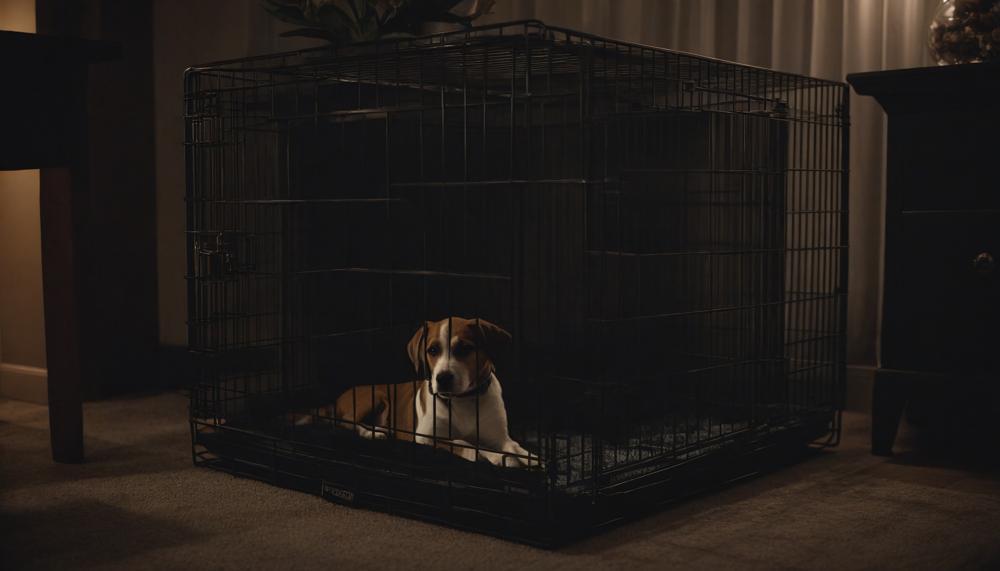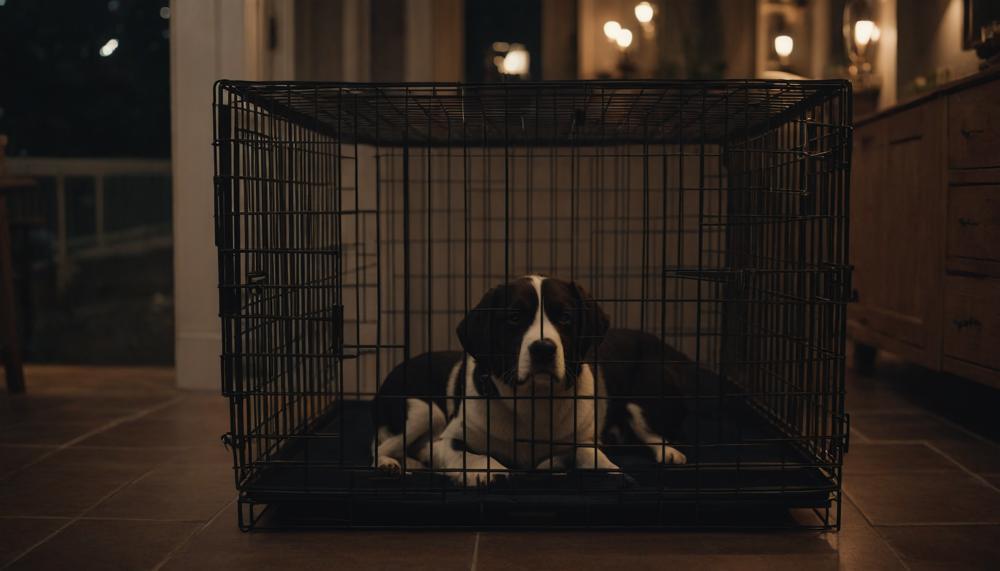Did you know that approximately 70% of pet owners in the U.S. use a crate at some point in their dog’s life for training or safety reasons? Yet, as beneficial as crates can be for managing behavior and ensuring safety, many owners aspire to one day transition their dog to sleeping freely throughout the home.
This significant shift not only symbolizes a milestone in trust and training but also offers your furry friend the comfort and freedom they deserve at night.
Transitioning your dog from a nightly crate routine to free roaming can be a liberating experience for both pet and owner. It requires patience, understanding, and a well-thought-out strategy to ensure a smooth adjustment. Here are some key insights to keep in mind during this transition:
- Gradual Adjustment: Begin with short, supervised periods out of the crate while you are home, gradually increasing the time as your dog shows readiness and comfort.
- Choose the Right Spot: Establish a specific, comfortable spot for your dog to sleep that is not the crate. This could be a cozy dog bed in a quiet corner of your bedroom or living area.
- Nighttime Readiness: Most dogs, especially by the age of 6 months, can sleep through the night without a bathroom break. However, be prepared to take them out once or twice if they show signs of discomfort or restlessness during the initial nights.
- Consistent Routine: Maintain a consistent bedtime routine to help your dog understand when it’s time to settle down for the night.
By embracing these practices, you’re not just opening the crate door; you’re opening up a new chapter of trust and companionship with your dog.
When Can I Start Leaving My Dog Out of the Crate?
Table of Contents
- 1 When Can I Start Leaving My Dog Out of the Crate?
- 2 When Is My Puppy Ready to Sleep Out of the Crate?
- 3 Leaving Your Dog Out of the Crate During the Day
- 4 Transition Your Dog from a Crate to a Bed at Night
- 5 Troubleshooting: How to Address Issues When Leaving Your Dog Out of Their Crate at Night
- 6 Conclusion
The decision to stop crating your dog at night hinges on a few pivotal factors which must be carefully evaluated to ensure a smooth transition for your furry companion. Here’s a structured approach to determine the right timing and strategy:
| Factor | Details | Consideration |
| Age and Development | Dogs generally reach a stage by 6 months where they can last the night without a toilet break. | Assess if your dog is mature enough and can comfortably hold their needs through the night. |
| Behavioral Readiness | Observe your dog’s behavior both during the day and at night. | Ensure they are calm and do not display anxiety or destructive behavior when left alone. |
| Transition Process | Gradually increase the time your dog spends out of the crate while you are home. | Start with short periods and extend as your dog shows reliability and comfort. |
| Sleeping Environment | Choose a safe, comfortable space for your dog that mimics the security of a crate. | Ensure the area is escape-proof and devoid of hazards, with comfortable bedding. |
| Individual Needs | Every dog is unique; some might need more time to adjust than others. | Continuously monitor and adapt based on your dog’s specific reactions and progress. |
In essence, your dog can start spending nights outside the crate once they are mature enough to handle it emotionally and physically, and when they’ve shown they can behave appropriately without supervision.

When Is My Puppy Ready to Sleep Out of the Crate?
This pivotal moment in your puppy’s life hinges on several developmental milestones that ensure they are ready for this new freedom. Here’s a direct rundown on determining when your pup can start sleeping outside the crate at night:
- Complete House Training: Ensure your puppy is consistently signalling when they need to go outside and hasn’t had accidents for a sustained period.
- Crate Training Mastery: Your puppy should feel comfortable in their crate before moving out of it, demonstrating they can stay calm and quiet throughout the night.
- Behavioral Readiness: Look for signs of decreased anxiety when left alone and no destructive behavior when out of the crate during the day.
- Safety of the Environment: The area where your puppy will sleep must be secure, with no hazards that could harm them if unsupervised.
- Health and Comfort: The puppy should be in good health, showing no signs of discomfort that might worsen without the confinement of a crate.
To integrate these factors smoothly, consider a gradual transition. Start by allowing your puppy to nap outside the crate during the day while you’re home. If these sessions go well, progressively increase their freedom at night.
Here’s a structured way to track your puppy’s readiness:
| Criterion | Status | Notes |
| House Training Completion | Yes/No | Monitor for consistent signals and no accidents. |
| Crate Training Mastery | Yes/No | Ensure comfort in crate before transitioning. |
| Behavioral Stability | Yes/No | Check for calmness and non-destructive habits. |
| Environmental Safety | Yes/No | Inspect sleep area for potential hazards. |
| Health Status | Good/Poor | Confirm puppy is healthy and comfortable. |
Leaving Your Dog Out of the Crate During the Day
To ensure your dog is safe and content when left out of the crate during the day, follow these structured and clear tips:
| Gradual Transition | Start by leaving your dog out for short periods and gradually increase the time as they show they can handle it without anxiety or destructive behavior. |
| Safe Space Setup | Create a designated safe area in your home where your dog can relax. This space should be free of hazards and equipped with a comfortable bed and their favorite toys. |
| Engagement Tools | Provide puzzle toys and treats that require time and effort to solve. These keep your dog mentally stimulated and reduce boredom-related issues. |
| Houseproofing | Ensure all potential hazards are out of reach. Secure electrical cords, toxic plants, and breakable items to prevent accidents while you’re away. |
| Regular Exercise | Make sure your dog has plenty of physical activity before you leave them out of the crate. A tired dog is less likely to get into trouble due to excess energy. |
| Surveillance and Interaction | Consider using a pet camera with two-way audio. This allows you to monitor their behavior and interact with them even when you’re not home. |
| Consistent Routine | Establish a consistent daily routine that includes times for feeding, toileting, and play. Dogs thrive on predictability, which can reduce anxiety when left alone. |
Implementing these steps will help your dog transition smoothly from crate training to enjoying more freedom safely.
Transition Your Dog from a Crate to a Bed at Night
Transitioning your dog from a crate to a bed at night is an exercise in patience and understanding. Here’s a detailed guide to make this shift as seamless as possible for both you and your dog.
- Start Gradually: Begin by placing the dog’s bed in the same location as the crate. Allow your dog to explore and rest on the bed during the day. This familiarity will help ease the transition at night.
- Ensure Housebreaking: Before fully transitioning, confirm that your dog is reliably housebroken. This ensures they won’t have accidents during the night, which could disrupt their sleep and yours.
- Choose the Right Bed: Invest in a comfortable, size-appropriate bed for your dog. The bed should be inviting and placed in a quiet, warm area that mimics the security of their crate.
- Maintain a Routine: Keep your dog’s bedtime routine consistent. Activities like a pre-bedtime walk and a set sleeping time provide stability, reinforcing that the new bed is now the place for nighttime sleep.
- Night-Time Assistance: Initially, you might need to take your dog out during the night to prevent accidents. This also reassures your dog that you are nearby, providing comfort during the new sleeping arrangement.
- Monitor and Adjust: Observe your dog’s behavior and comfort levels. Some dogs may take to a new bed quickly, while others need more time. Adjustments might be necessary depending on their reactions.
Here’s a table summarizing the transition steps:
| Step | Action | Detail |
| 1 | Gradual Introduction | Introduce the bed in the same location as the crate, allowing daytime exploration. |
| 2 | Confirm Housebreaking | Ensure your dog is fully housebroken to prevent night-time accidents. |
| 3 | Select Appropriate Bed | Choose a comfortable bed suitable for your dog’s size and place it in a cozy spot. |
| 4 | Keep Consistent Routine | Maintain the same pre-bedtime routine to help your dog adjust to the new sleeping area. |
| 5 | Provide Night-Time Assistance | Be prepared to assist your dog during the night if needed during the initial transition. |
| 6 | Adjust Based on Observations | Monitor your dog’s adjustment and make necessary changes to ease their transition. |
Troubleshooting: How to Address Issues When Leaving Your Dog Out of Their Crate at Night
Leaving your dog out of their crate at night might stir up some hiccups, but with a practical strategy, these can be ironed out effectively. Below is a guide that details steps and potential remedies for common issues:
| Issue | Potential Solution | Preventative Measure |
| Restlessness or Whining | Ensure a comfortable sleeping area with familiar items like toys or a blanket. Consider a white noise machine or soft music to soothe them. | Gradually increase the time your dog spends out of the crate during the day to build comfort and familiarity with the new sleeping area. |
| Nighttime Wandering | Restrict access to certain parts of the house with baby gates or close doors. This helps limit the space they can explore at night. | Take your dog for a late evening walk to burn off excess energy before bedtime. |
| Anxiety or Stress | If signs of anxiety are present, such as pacing or barking, consult a veterinarian or a dog behaviorist for tailored advice. | Provide a consistent bedtime routine and calming bedtime activities like gentle petting or quiet play. |
| Accidents Indoors | Clean any accidents thoroughly with an enzymatic cleaner to prevent remarking. If accidents persist, consider a mid-night toilet break. | Ensure your dog has ample opportunities to relieve themselves right before bedtime. |
| Difficulty Settling | Place the dog’s bed in an area that remains dark and quiet at night. You might also try a special calming dog bed designed to reduce anxiety. | Use a consistent “bedtime” command and reward your dog for obeying to establish a routine that signals it’s time to sleep. |
Incorporating these steps should assist in smoothing the transition from crate to bed. Remember, some dogs may take longer to adjust, and factors like age, breed, and temperament play a role.
Patience and persistence are key. It’s also beneficial to engage with other dog owners online to share experiences and gain insights that might be specific to your dog’s breed or behavior.
Conclusion
In transitioning your dog from a crate to freely roaming at night, the journey unfolds not just as a milestone of training, but as a testament to the deepening bond and trust between you and your pet. The essence of this evolution lies in understanding your dog’s readiness, both behaviorally and developmentally, ensuring they are prepared for this new chapter without the confines of their crate.
To foster this shift successfully, a deliberate and patient approach is paramount. Start by introducing your dog to their new sleeping space during supervised, brief intervals, gradually extending these periods as comfort and confidence build. Choose a sleeping spot that offers the same sense of security as their crate did, equipped with familiar bedding and perhaps a cherished toy to ease the transition.
The readiness for such freedom isn’t merely about age; it’s intricately tied to your dog’s unique personality and needs. Consistent nighttime routines and a dedicated, safe sleeping environment are crucial. As you embark on this journey, remember that each small step is a leap towards a happier, more contented companion who feels as safe and secure in their new resting place as they did in their crate.






